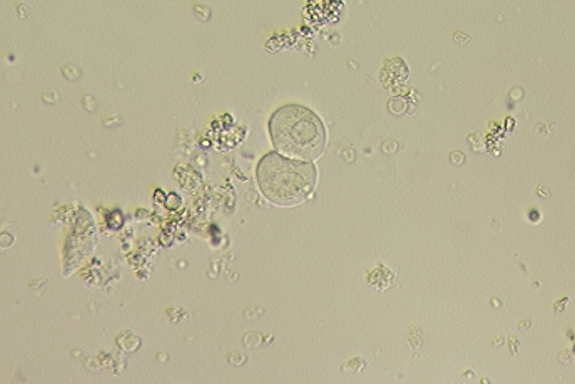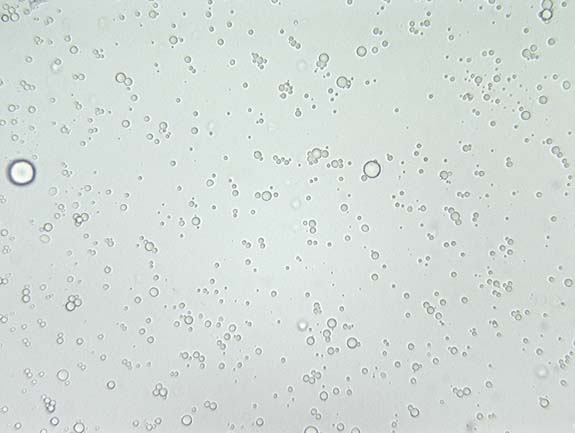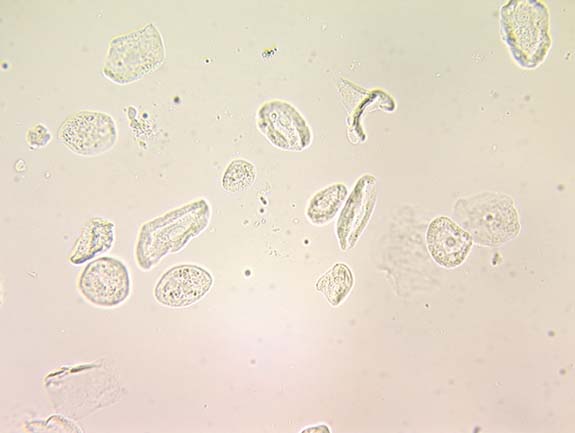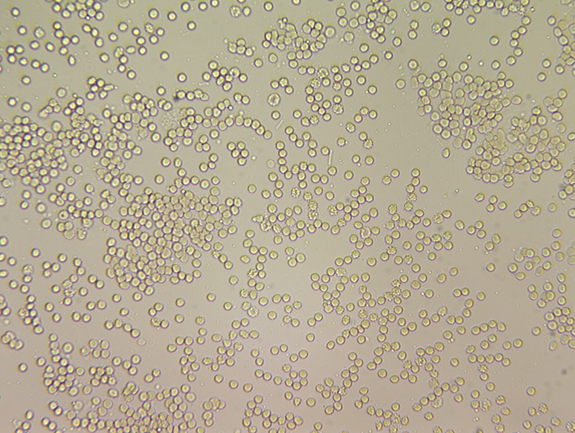Hematology & Urinalysis Quiz Questions
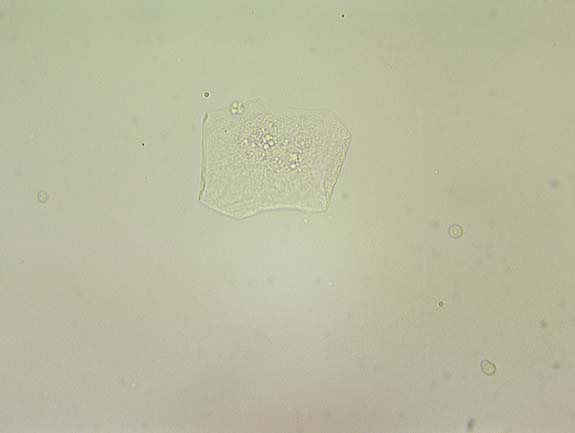
Blood cells and urinary sediment and stuff
from
Laboratory Urinalysis and Hemotology for the Small Animal Practitioner :)
- 1.
What kind of cell is this?
Correct Answer
Squamous Epithelial CellExplanation
This cell is a squamous epithelial cell. Squamous epithelial cells are flat and thin, resembling scales or plates. They are found in the lining of various organs and body cavities, such as the skin, lungs, and blood vessels. These cells provide protection, secretion, and absorption functions depending on their location in the body.Rate this question:
- 2.
What kind of cells are seen here?
Correct Answer
Epithelial Cells
Renal Tubular Epithelial Cells
Epithelial cellExplanation
The image shows cells that have a distinct epithelial cell morphology. These cells are arranged in a single layer and have a polygonal shape with clearly defined borders. Additionally, some cells have a brush border on their apical surface, which is a characteristic feature of renal tubular epithelial cells. Therefore, the correct answer is Epithelial Cells and Renal Tubular Epithelial Cells.Rate this question:
- 3.
WTF is that?!
Correct Answer
Fat Droplets
LipidsExplanation
The correct answer is Fat Droplets and Lipids. Fat droplets are small globules of fat that are found in various tissues of the body. Lipids are a broad group of organic compounds that include fats, oils, and other substances. Both fat droplets and lipids are related to each other as fat droplets are composed of lipids.Rate this question:
- 4.Correct Answer
Transitional Epithelial Cells - 5.
What are these? ?
Correct Answer
Red Blood Cells
Erythrocytes
RBCsExplanation
These terms refer to the same thing, which are the cells in our blood that carry oxygen to the body's tissues. They are called red blood cells because they contain a protein called hemoglobin, which gives them their red color. Erythrocytes is the scientific term for red blood cells, and RBCs is the abbreviation for the same.Rate this question:
- 6.Correct Answer
White Blood Cells
Leukocytes
WBCs - 7.
. What kind of cell is marked in white?
Correct Answer
Renal Tubular Epithelial Cell
Epithelial Cells
Epithelial CellExplanation
The correct answer is Renal Tubular Epithelial Cell. This is because the question asks for the specific type of cell that is marked in white, and the only option that mentions a specific type of cell is Renal Tubular Epithelial Cell. The other options simply mention "Epithelial Cells" or "Epithelial Cell" without specifying a particular type. Therefore, the correct answer is Renal Tubular Epithelial Cell.Rate this question:
- 8.Correct Answer
Hyaline Cast
Cast - 9.Correct Answer
Granular Cast
Cast - 10.
What is labeled in yellow?
Correct Answer
Red Blood Cell
RBC
ErythrocyteExplanation
The correct answer options for this question are all different terms used to refer to the same thing, which is a red blood cell. "Red Blood Cell," "RBC," and "Erythrocyte" are all labels for the same component of the blood.Rate this question:
- 11.
What is labeled in yellow?
Correct Answer
Epithelial cellExplanation
The yellow label in the question refers to an epithelial cell.Rate this question:
- 12.
What are labeled in yellow?
Correct Answer
Fat Droplets
LipidsExplanation
The items labeled in yellow are fat droplets and lipids. Fat droplets are small globules of fat that are found in various cells of the body. Lipids, on the other hand, are a group of organic compounds that include fats, oils, and cholesterol. Both fat droplets and lipids are important for energy storage and insulation in the body.Rate this question:
- 13.
What is labeled in yellow?
Correct Answer
White Blood Cells
Leukocytes
WBCsExplanation
The items labeled in yellow are White Blood Cells, Leukocytes, and WBCs. White Blood Cells are a type of blood cell that helps the body fight off infections and diseases. Leukocytes is another term used to refer to white blood cells. WBCs is an abbreviation for White Blood Cells. Therefore, all three terms are correct and represent the same thing.Rate this question:
- 14.
What is marked in red?
Correct Answer
Calcium Oxalate Crystals
Calcium OxalateExplanation
The answer is Calcium Oxalate Crystals because it is the specific substance that is marked in red. Calcium Oxalate, on the other hand, is a more general term that does not specify the form or appearance of the substance. Therefore, the correct answer is Calcium Oxalate Crystals.Rate this question:
- 15.
What is marked in purple?
Correct Answer
RBCs
Red blood cellsExplanation
The correct answer is RBCs, which stands for red blood cells. Red blood cells are marked in purple.Rate this question:
- 16.
What is marked in yellow?
Correct Answer
Fat Droplets
LipidsExplanation
The correct answer is Fat Droplets and Lipids. The question is asking what is marked in yellow, implying that there is something marked in yellow in the given information. The information provided lists "Fat Droplets" and "Lipids" as separate items, suggesting that both are marked in yellow.Rate this question:
- 17.
What is marked in black?
Correct Answer
Cast
Fatty Cast - 18.
What is marked in yellow?
Correct Answer
CaOx
Calcium OxalateExplanation
The substance marked in yellow is CaOx, which stands for Calcium Oxalate. Calcium Oxalate is a compound made up of calcium ions and oxalate ions. It is commonly found in kidney stones and can also be found in certain foods. The yellow marking indicates that this particular substance is being referred to in the given context.Rate this question:
- 19.Correct Answer
Struvites
Triple Phosphate Crystals
Struvite Crystals
Magnesium ammonium phosphate crystals - 20.Correct Answer
Spermatozoa
Sperm - 21.Correct Answer
Bacteria
bacillus
rods
bacilli - 22.
Urine sediment exams are first viewed at 40x when looking for crystals, then at 100x when looking for cells or bacteria.
- A.
True
- B.
False
Correct Answer
B. FalseExplanation
Start at 10x and move to 40x.Rate this question:
-
- 23.
Which crystals can form in Alkaline urine?
- A.
Amorphous phosphates
- B.
Calcium Oxalate
- C.
Struvite
- D.
Amorphous urates
- E.
Ammonium biurate
- F.
Cystine
- G.
Triple Phosphate
Correct Answer(s)
A. Amorphous phosphates
C. Struvite
E. Ammonium biurate
G. Triple PhosphateExplanation
Certain crystals can form in alkaline urine due to the presence of specific substances. Amorphous phosphates, struvite, ammonium biurate, and triple phosphate are all examples of crystals that can form in alkaline urine. Amorphous phosphates are composed of calcium and phosphate and can be seen in alkaline urine. Struvite crystals are composed of magnesium, ammonium, and phosphate, and they typically form in the presence of urinary tract infections. Ammonium biurate crystals are formed from the breakdown of uric acid and are commonly seen in alkaline urine. Triple phosphate crystals, also known as magnesium ammonium phosphate crystals, can form in alkaline urine and are often associated with urinary tract infections.Rate this question:
-
- 24.
Calcium carbonate crystals are commonly seen in normal horses and dogs.
- A.
True
- B.
False
Correct Answer
B. FalseExplanation
Horses & cattleRate this question:
-
- 25.
What kind of crystals can be seen in animals with ethylene glycol toxicity?
- A.
Ammonium biurate
- B.
Monohydrate calcium oxalate
- C.
Amorphous urates
Correct Answer
B. Monohydrate calcium oxalateExplanation
Monohydrate calcium oxalate crystals can be seen in animals with ethylene glycol toxicity. Ethylene glycol is metabolized into oxalic acid, which then combines with calcium to form calcium oxalate crystals. These crystals can accumulate in the kidneys and other organs, leading to renal damage and other complications. Ammonium biurate and amorphous urates are not specifically associated with ethylene glycol toxicity.Rate this question:
-
Quiz Review Timeline +
Our quizzes are rigorously reviewed, monitored and continuously updated by our expert board to maintain accuracy, relevance, and timeliness.
-
Current Version
-
Mar 22, 2023Quiz Edited by
ProProfs Editorial Team -
Oct 14, 2014Quiz Created by
Pasty
 Back to top
Back to top



